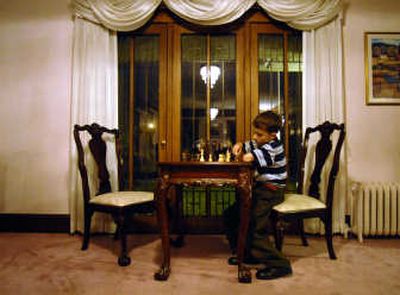Homes, sweet homes

Luxury, beauty and architectural elegance are all hallmarks of Rockwood district homes, four of which will be featured during the Spokane Preservation Advocates Holiday Heritage Home Tour Saturday, from noon until 4 p.m..
The Rockwood district’s neighborhood design, created in the early 1900s by the Olmsted Brothers Landscape Architectural Firm (also known for their design of New York’s Central Park), created a high-end residential area that has also preserved the area’s natural beauty for 100 years, with tree-lined roads curving around basalt bluffs.
Nestled in the natural beauty of this walkable neighborhood, the tour homes – which include the former residences of Spokane sporting catalyst Joe Albi and mining entrepreneurs Pauline and Conrad Wolfle – represent some of the best architecture and workmanship of that time period in Spokane. They are lived-in art.
“Each property has an amazing history and a story to tell,” says Linda Yeomans, a historic preservation consultant and the tour chairperson. “It excites me that the home owners are willing to allow the public to come through and see the fabulous things that make these homes so special.”
Avery-McClintock House
505 E. Rockwood Boulevard: The Avery-McClintock House, designed by Spokane architect Earl W. Morrison and built in 1912 by Amil T. Johnson for the then astronomical sum of $45,000, resembles the fairytale charm of a 19th century thatched-roof cottage in the English countryside, but with the luxurious size and grandeur of wealthy landowner’s manor and a Tudor revival influence.
Once the home of Spokane County Supreme Court Justice George Avery and later, Robert McClintock, a pioneering wholesale grocer, the Avery-McClintock House features rich rosewood mahogany and hand-rubbed quarter-sawn oak woodwork. The green-tiled fireplace, beautiful on any day, becomes a stunning focal point when the home is decorated for Christmas, as all these homes will be for the tour.
Joe and Mazie Albi House
525 E. 12th Avenue: The Joe and Mazie Albi House, a Craftsman-style bungalow has a modest exterior that belies the superior workmanship of its interior woodwork and significance to Spokane’s history.
The home, built in 1912 by Walter Weld, was reportedly given to Joe and Mazie Albi as a wedding gift from Albi’s parents. The Spokane sporting icon lived here with his wife for 47 years. During that time the attorney and philanthropist helped found the Spokane Athletic Round Table and was a driving force behind Esmeralda Golf Course and the stadium later named for him.
Its many built-ins, including bookcases and a drop-leaf desk in the den and a china cabinet and buffet in the dining room, demonstrate the fine golden-oak woodworking of the day.
Wolfle-Trunkey House
415 E. 12th Avenue: The Wolfle-Trunkey House, built in 1912 by Amil T. Johnson, is one of few, and certainly the best, example of Prairie-style architecture in the Spokane area, says Yeomans. With a horizontal design made popular in the Midwest by Frank Lloyd Wright to take advantage of sweeping prairie views, this home features rows of windows under wide eaves which cast a dance of light and shadow across the walls.
Built for mining entrepreneurs Pauline and Conrad Wolfle and later occupied by Harvey and Mary Trunkey, relatives and partners of the McClintocks, this home’s interior mixes Craftsman and Prairie architectural influences with an open floor plan and generous use of oak woodwork and flooring and a prominent fireplace.
Dyar-Kiesling House
526 E. 12th Avenue: The Dyar-Kiesling House, built in 1912 with an American Foursquare meets Craftsman style detail, features a large covered front porch with a black basalt porch wall mirroring the natural basalt of the area. Filled with golden-oak woodwork and built-in furniture, the warm hues of the wood served as a cozy backdrop for Ralph E. Dyar and his wife Else Kiesling Dyar, who owned the home for 40 years. Dyar was a Spokane playwright, author and Spokesman-Review director of promotion and research. He was best known for his 1928 play, “A Voice in the Dark,” which was produced as a Hollywood motion picture.
As an added treat on the tour, the current homeowners have period appropriate furniture and museum quality antiques, says Yeomans.
“We have four really great homes,” she says. “All of these homes are one of a kind.”